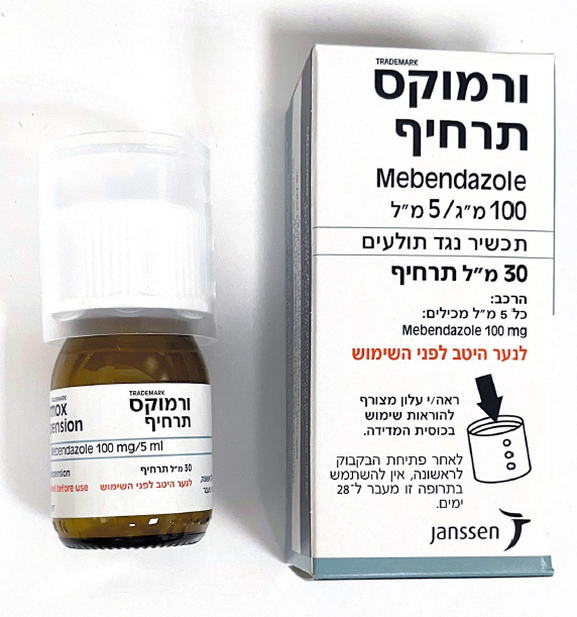Quest for the right Drug

ורמוקס תרחיף VERMOX SUSPENSION (MEBENDAZOLE)
תרופה במרשם
תרופה בסל
נרקוטיקה
ציטוטוקסיקה
צורת מתן:
פומי : PER OS
צורת מינון:
תרחיף : SUSPENSION
עלון לרופא
מינוניםPosology התוויות
Indications תופעות לוואי
Adverse reactions התוויות נגד
Contraindications אינטראקציות
Interactions מינון יתר
Overdose הריון/הנקה
Pregnancy & Lactation אוכלוסיות מיוחדות
Special populations תכונות פרמקולוגיות
Pharmacological properties מידע רוקחי
Pharmaceutical particulars אזהרת שימוש
Special Warning עלון לרופא
Physicians Leaflet
Pharmacological properties : תכונות פרמקולוגיות
Pharmacodynamic Properties
5.1 Pharmacodynamic properties Pharmacotherapeutic group: anthelmintic for oral administration, benzimidazole derivatives; ATC code: P02CA01. In vitro and in vivo work suggests that mebendazole blocks the uptake of glucose by adult and larval forms of helminths, in a selective and irreversible manner. Inhibition of glucose uptake appears to lead to endogenous depletion of glycogen stores within the helminth. Lack of glycogen leads to decreased formation of ATP and ultrastructural changes in the cells. There is no evidence that Vermox is effective in the treatment of cysticercosis.
Pharmacokinetic Properties
5.2 Pharmacokinetic properties Absorption Following oral administration, < 10% of the dose reaches the systemic circulation, due to incomplete absorption and pre-systemic metabolism (first-pass effect). The majority of an orally administered dose remains in the gastrointestinal tract. Maximum plasma concentrations are generally seen 2 to 4 hours after administration. Administration with a high fat meal increases the bioavailability of mebendazole, but the overall effect of food on the amount of drug remaining in the gastrointestinal tract is not expected to be substantial. Distribution The plasma protein binding of mebendazole is 90 to 95%. The volume of distribution is 1 to 2 L/kg, indicating that mebendazole penetrates areas outside the vascular space. This is supported by data in patients on chronic mebendazole therapy (e.g., 40 mg/kg/day for 3-21 months) that show drug levels in tissue. Metabolism Orally administered mebendazole is extensively metabolised primarily by the liver. Plasma concentrations of its major metabolites (hydrolysed and reduced forms of mebendazole) are substantially higher than those of mebendazole. Impaired hepatic function, impaired metabolism, or impaired biliary elimination may lead to higher plasma levels of mebendazole. Elimination Mebendazole, the conjugated forms of mebendazole, and its metabolites likely undergo some degree of enterohepatic recirculation and are excreted in the urine and bile. The apparent elimination half-life after an oral dose ranges from 3 to 6 hours in most patients. Steady-state pharmacokinetics During chronic dosing (e.g., 40 mg/kg/day for 3-21 months), plasma concentrations of mebendazole and its major metabolites increase, resulting in approximately 3-fold higher exposure at steady-state compared to single dosing. Paediatric population Limited data of the mebendazole concentrations in plasma are available in children and adolescents 1 to 16 years of age. These data do not indicate substantially higher systemic exposure to mebendazole in subjects 3 to 16 years of age compared to adults. In subjects 1 to <3 years of age, systemic exposure is higher than in adults due to higher mg/kg dose relative to adults.

שימוש לפי פנקס קופ''ח כללית 1994
Ascariasis, enterobiasis (oxyuriasis), trichuriasis. Ancylostoma, necator, echinococcus granulosus
תאריך הכללה מקורי בסל
01/01/1995
הגבלות
תרופה שאושרה לשימוש כללי בקופ'ח
מידע נוסף
